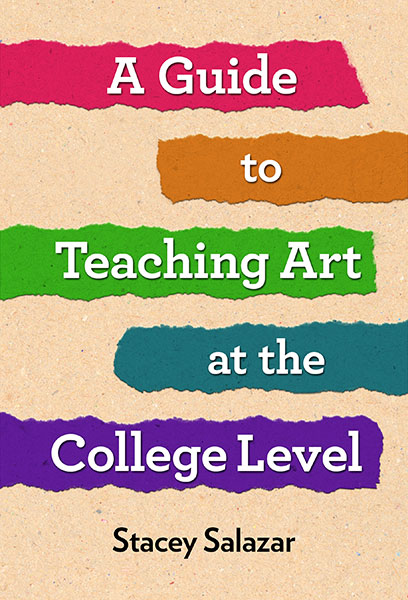Professors: Request an Exam Copy
Print copies available for US orders only. For orders outside the US, see our international distributors.
Publication Date: September 24, 2021
Pages: 176

This accessible guide will help studio art and design professors meaningfully and effectively transform their curriculum and pedagogy so that it is relevant to today’s learners. Situating contemporary college teaching within a historic art and design continuum, the author provides a practical framework for considering complex interactions within art and design pedagogy. Readers will gain a deeper appreciation of college students and their learning, an understanding of teaching repertoires, and insight into the local and global contexts that impact teaching and learning and how these are interrelated with studio content. Throughout, Salazar expertly weaves research, theory, and helpful advice that instructors can use to enact a mode of teaching that is responsive to their unique environment. The text examines a variety of educational practices, including reflection, critique, exploration, research, student-to-student interaction, online teaching, intercultural learning, and community-engaged curricula.
Book Features:
Stacey Salazar is the vice provost for graduate studies at the Maryland Institute College of Art. A college art educator for nearly 30 years, she has received professional recognition for her teaching and research. She holds a doctorate in education and a Master of Fine Arts in painting.
“A Guide to Teaching Art at the College Level translates the formal language of education into straightforward, comprehensible concepts and ties these to practical steps that higher education art instructors can readily apply to their teaching. Drawing on her own classroom experience, Salazar helps artists retool their practice for the instructional and learning demands of the current moment.”
—Richard Siegesmund, professor, art and design education, Northern Illinois University
“In A Guide to Teaching Art at the College Level, Stacey Salazar generously gifts new and experienced college art teachers with a richly detailed, immediately usable pedagogical toolkit assembled from her many years as an adjunct and full-time teacher of art, a highly respected teacher of teachers, and a prolific researcher. It is exactly what we need right now to overlay art and teaching theory and philosophy with actual practice, to, as she puts it, ‘disrupt, in the most benevolent sense, or reimagine the relationship between college art-and-design education and professional art worlds.’”
—Mary Hafeli, professor of art and art education, Teachers College, Columbia University
“Whether read to inform, refresh, or make one's teaching more engaging and worthwhile for oneself and one’s students, college teachers of art and design will find this book provides an astute synthesis of history, theory, and practice with candor and insight—all in an easy-to-read format. The guide is rich in content, and provocative yet practical. It addresses contemporary issues and expectations of faculty and the content is deeply grounded in literature and practice. In addition to offering any faculty member teaching art and/or design the opportunity to enrich their teaching, Salazar's book is an outstanding resource and a great text for anyone teaching a course in the college teaching of art and design or for those called upon to provide preparation for new faculty members entering the profession. Essential reading.”
—Karen Lee Carroll, dean emeritus, Center for Art Education, Maryland Institute College of Art
Contents
Acknowledgments ix
PART I: THE CONTEXT FOR A GUIDE TO TEACHING ART AT THE COLLEGE LEVEL
1. Introduction 3
Why a Guide to Teaching Art at the College Level? 3
The College Teaching of Art as a Complex System 10
TLCS: A Framework 12
What’s in This Book? 14
A Final Thought Before Proceeding 17
2. A History 19
Introduction 19
The Medieval Atelier 20
The Academy 20
Modern Western European Models 23
Modern Western European Models in the United States 25
Postmodern Pedagogues 29
A Postmodern Polyphony 31
Patterns Across History 31
Conclusion 32
PART II: USING THE TLCS FRAMEWORK FOR TEACHING ART AT THE COLLEGE LEVEL
3. Teacher 35
Introduction 35
Contemporary Considerations: College Teachers Today 35
Snapshot of the Research: Teachers and Teaching 38
Reflection and Action 41
Teaching Strategies 45
Further Reading 49
Conclusion 49
4. Learner 51
Introduction: Know the Learner 51
Contemporary Considerations: College Students Today 51
Snapshot of the Research: Learners and Learning 55
Reflection and Action 59
Teaching Strategies 60
Further Reading 62
Conclusion 63
5. Context 64
Introduction 64
Contemporary Considerations: Higher Education Today 64
Snapshot of the Research: Art-and-Design Contexts 71
Reflection and Action 73
Teaching Strategies 74
Further Reading 76
Conclusion 77
6. Studio Content 78
Introduction 78
Contemporary Considerations: Creativity Today 78
Snapshot of the Research: Conditions Conducive to Creativity 81
Reflection and Action 86
Teaching Strategies 87
Further Reading 91
Conclusion 92
PART III: PRACTICAL TOOLS
7. Creating Assignments 95
Introduction 95
Defining and Facilitating Inquiry 95
A Flexible Holistic Model 96
Using the Flexible Holistic Model 100
A Note on Curriculum Development 103
Further Reading 103
Conclusion 104
8. Doing Assessment 105
Introduction 105
Assessing Learning at the College Level 105
Aligning Assessment Practices with Course Learning Outcomes 109
Further Reading 114
Conclusion 114
9. Documenting Teaching 115
Introduction 115
The Syllabus 115
The Teaching Philosophy 121
Further Reading 123
Conclusion 124
Epilogue 125
Notes 129
Index 157
About the Author 166
Professors: Request an Exam Copy
Print copies available for US orders only. For orders outside the US, see our international distributors.